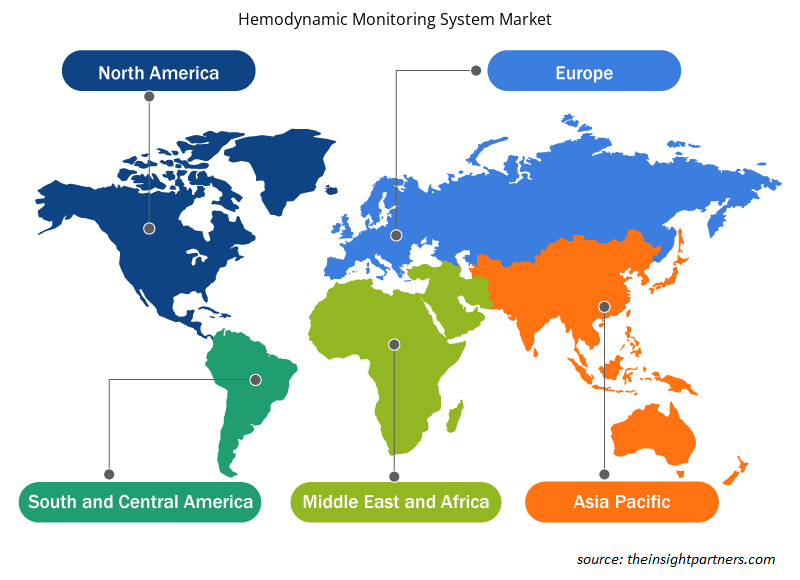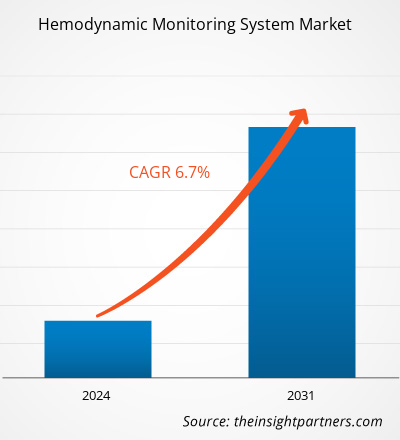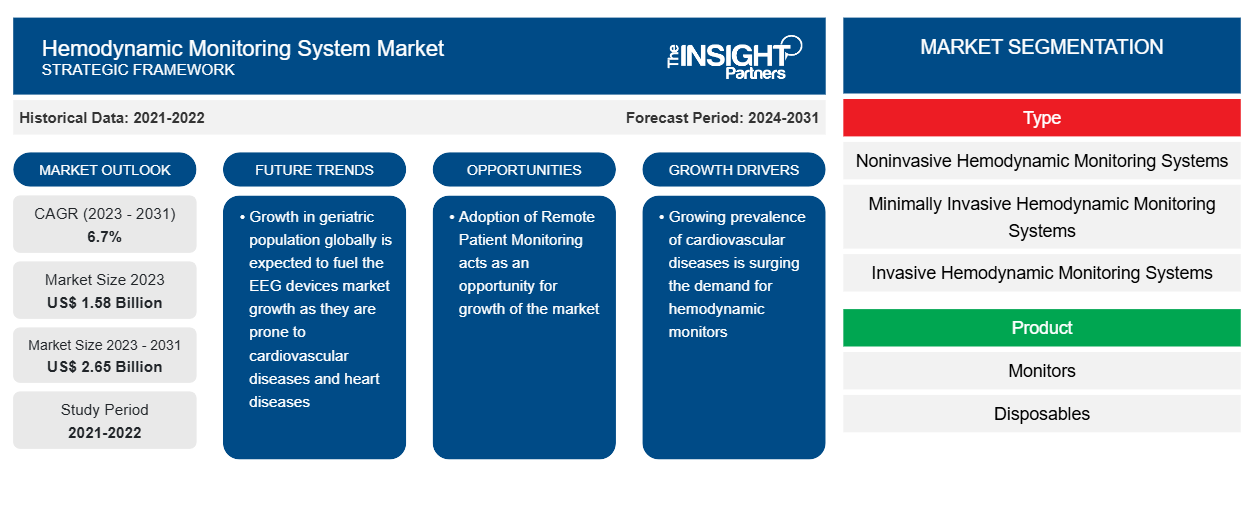من المتوقع أن يصل حجم سوق نظام مراقبة الدورة الدموية إلى 2.65 مليار دولار أمريكي بحلول عام 2031 من 1.58 مليار دولار أمريكي في عام 2023. ومن المتوقع أن يسجل السوق معدل نمو سنوي مركب بنسبة 6.7٪ خلال الفترة 2023-2031. ومن المرجح أن يظل استخدام الذكاء الاصطناعي والتعلم الآلي الاتجاه الرئيسي في السوق.
تحليل سوق نظام مراقبة الدورة الدموية
يستخدم نظام مراقبة الدورة الدموية لمراقبة الدورة الدموية للمريض وتقييم صحة القلب. وبالتالي، فإن زيادة انتشار أمراض القلب بسبب تزايد عدد السكان المسنين واكتشاف حالات القلب عند الأطفال يغذي الطلب على نظام مراقبة الدورة الدموية. بالإضافة إلى ذلك، فإن زيادة الاستثمار في البحث والتطوير لنظام مراقبة الدورة الدموية، ومبادرات التوعية بصحة القلب، والتركيز المتزايد على سلامة المرضى وجودة الرعاية، تدفع نمو سوق نظام مراقبة الدورة الدموية. علاوة على ذلك، فإن الطلب المتزايد على مراقبة الرعاية الحرجة في وحدات العناية المركزة وأقسام الطوارئ وغرف العمليات يغذي أيضًا نمو السوق. يعمل توسيع خدمات الرعاية الصحية المنزلية وبرنامج مراقبة المرضى عن بعد كفرصة لنمو السوق في فترة التنبؤ.
نظرة عامة على سوق نظام مراقبة الدورة الدموية
من المتوقع جغرافيًا أن تسجل منطقة آسيا والمحيط الهادئ أعلى معدل نمو سنوي مركب في الفترة المتوقعة 2023-2031. إن التركيز المتزايد على اللاعبين في السوق في تقديم المنتجات المتقدمة تقنيًا في منطقة آسيا والمحيط الهادئ، والتبني المتزايد لخدمات الرعاية الصحية المنزلية ، والطلب المتزايد على تقنيات التشخيص غير الجراحية، وزيادة أنشطة البحث والتطوير، كل ذلك يغذي نمو سوق نظام مراقبة الدورة الدموية في منطقة آسيا والمحيط الهادئ. علاوة على ذلك، فإن النمو السكاني لكبار السن، وارتفاع الإنفاق على الرعاية الصحية، وزيادة انتشار أمراض القلب والأوعية الدموية (CVDS)، وتحسين الدعم الحكومي لخلق الوعي بصحة القلب، كل ذلك يغذي نمو السوق في منطقة آسيا والمحيط الهادئ.
قم بتخصيص هذا التقرير ليناسب متطلباتك
ستحصل على تخصيص لأي تقرير - مجانًا - بما في ذلك أجزاء من هذا التقرير، أو تحليل على مستوى الدولة، وحزمة بيانات Excel، بالإضافة إلى الاستفادة من العروض والخصومات الرائعة للشركات الناشئة والجامعات
-
احصل على أهم اتجاهات السوق الرئيسية لهذا التقرير.ستتضمن هذه العينة المجانية تحليلاً للبيانات، بدءًا من اتجاهات السوق وحتى التقديرات والتوقعات.
محركات وفرص سوق نظام مراقبة الدورة الدموية
تزايد انتشار أمراض القلب والأوعية الدموية لصالح السوق
تتسبب أمراض القلب والأوعية الدموية في ملايين الوفيات كل عام في جميع أنحاء العالم. وفقًا لورقة حقائق التحديث الإحصائي لأمراض القلب والسكتة الدماغية لعام 2022، العبء العالمي للأمراض، توفي ما يقدر بنحو 119.1 مليون شخص بسبب أمراض القلب والأوعية الدموية في عام 2020. كما ذكرت أن الانتشار العالمي للسكتة الدماغية والسكتة الدماغية الإقفارية في عام 2020 كان 89.1 مليون و 68.2 مليون على التوالي. الأسباب الرئيسية لأمراض القلب والأوعية الدموية هي ارتفاع ضغط الدم والسمنة والسكري. وفقًا لمنظمة الصحة العالمية (WHO)، يُفقد حوالي 17.9 مليون شخص بسبب أمراض القلب والأوعية الدموية كل عام، أي حوالي 32٪ من جميع الوفيات المبلغ عنها عالميًا. الوعي بشأن الإنعاش القلبي الرئوي مرتفع في الدول الغربية. وفقًا لمراكز السيطرة على الأمراض والوقاية منها (CDC)، تحدث حوالي 350.000 حالة من السكتة القلبية خارج المستشفى (OHCA) في الولايات المتحدة كل عام. تسمح أجهزة مراقبة الدورة الدموية بقياس وظائف القلب والدورة الدموية لدى مرضى القلب . يتيح هذا النظام للأطباء قياس ضغط الدم من داخل الأوردة والشرايين والقلب. وبالتالي، فإن الانتشار المتزايد لأمراض القلب والأوعية الدموية يزيد من الطلب على أجهزة مراقبة الدورة الدموية.
اعتماد مراقبة المرضى عن بعد يشكل فرصة لنمو السوق
من خلال مراقبة العلامات الحيوية للمريض عن بعد، يمكن لمهنيي الرعاية الصحية تجنب الدخول إلى مرافق الرعاية الصحية. وإذا كان من الممكن التعامل مع الحالات افتراضيًا، فسيتم حجز الأسرّة فقط للمرضى الذين يحتاجون إلى رعاية حرجة، مما يسمح لإدارات المستشفيات بإدارة مواردها بشكل أكثر فعالية. يؤدي التحول من المرافق طويلة الأجل وإعادة التأهيل للمرضى الداخليين ومرافق التمريض الماهرة إلى إعدادات الرعاية المنزلية إلى زيادة فرص التفاعل الأفضل والمتسق والسريع بين المريض والطبيب بسبب الأهمية المتزايدة للأجهزة الطبية التي تعمل بالسحابة والتنقل. زيادة اعتماد مراقبة المريض عن بعد من خلال دمج الأجهزة مع السجلات الطبية الإلكترونية (EMR) لتحليل النتائج في الوقت الفعلي مما يخلق فرصة لنمو أجهزة مراقبة الدورة الدموية.
تقرير تحليل تجزئة سوق نظام مراقبة الدورة الدموية
إن القطاعات الرئيسية التي ساهمت في اشتقاق تحليل سوق نظام مراقبة الدورة الدموية هي المنتج والنوع والمستخدم النهائي.
- بناءً على النوع، ينقسم سوق نظام مراقبة الدورة الدموية إلى نظام مراقبة الدورة الدموية غير الجراحي، وأنظمة مراقبة الدورة الدموية قليلة التدخل، وأنظمة مراقبة الدورة الدموية الغازية. ينقسم قطاع نظام مراقبة الدورة الدموية غير الجراحي إلى نظام القلب غير الجراحي وغيرها. احتل قطاع نظام مراقبة الدورة الدموية الجراحي أكبر حصة في السوق في عام 2023.
- من حيث المنتج، ينقسم السوق إلى شاشات وأجهزة يمكن التخلص منها. وقد استحوذ قطاع الأجهزة التي يمكن التخلص منها على حصة كبيرة من السوق في عام 2023.
- بناءً على المستخدم النهائي، ينقسم سوق نظام مراقبة الدورة الدموية إلى المستشفيات ومختبرات القسطرة والرعاية المنزلية ومراكز الجراحة الخارجية. احتل قطاع المستشفيات أكبر حصة في السوق في عام 2023.
تحليل حصة سوق نظام مراقبة الدورة الدموية حسب المنطقة الجغرافية
ينقسم النطاق الجغرافي لتقرير سوق نظام مراقبة الدورة الدموية بشكل أساسي إلى خمس مناطق: أمريكا الشمالية، وآسيا والمحيط الهادئ، وأوروبا، والشرق الأوسط وأفريقيا، وأمريكا الجنوبية والوسطى.
سيطرت أمريكا الشمالية على السوق. ويعزى النمو المتوقع لسوق نظام مراقبة الدورة الدموية في أمريكا الشمالية إلى عوامل مثل زيادة الإنفاق الصحي، وارتفاع معدل انتشار أمراض القلب والأوعية الدموية، وزيادة الوعي بصحة القلب، وتزايد عدد السكان المسنين. إن انتشار أمراض القلب والأوعية الدموية في الولايات المتحدة أعلى بكثير، حيث يعاني أكثر من 50٪ من السكان من أنواع مختلفة من أمراض القلب والأوعية الدموية. ووفقًا لمراكز السيطرة على الأمراض والوقاية منها (CDC)، يموت أكثر من 0.6 مليون شخص كل عام بسبب أمراض القلب والأوعية الدموية؛ وهذا يمثل ما يقرب من واحد من كل أربع وفيات. والسبب الرئيسي لأمراض القلب والأوعية الدموية بين الناس هو ارتفاع ضغط الدم والسمنة والسكري. علاوة على ذلك، تركز العديد من المنظمات على تقديم برامج لرعاية وعلاج أمراض القلب والأوعية الدموية وخلق الوعي بهذه العلاجات في المكسيك. على سبيل المثال، في يونيو 2022، أطلقت جمعية القلب الأمريكية برنامجًا لمدة عامين بتمويل من نوفارتيس المكسيك لتحسين اتساق الرعاية لأمراض القلب والأوعية الدموية.
رؤى إقليمية حول سوق أنظمة مراقبة الدورة الدموية
لقد قام المحللون في Insight Partners بشرح الاتجاهات والعوامل الإقليمية المؤثرة على سوق نظام مراقبة الدورة الدموية طوال فترة التوقعات بشكل شامل. يناقش هذا القسم أيضًا قطاعات سوق نظام مراقبة الدورة الدموية والجغرافيا في جميع أنحاء أمريكا الشمالية وأوروبا ومنطقة آسيا والمحيط الهادئ والشرق الأوسط وأفريقيا وأمريكا الجنوبية والوسطى.

- احصل على البيانات الإقليمية المحددة لسوق نظام مراقبة الدورة الدموية
نطاق تقرير سوق نظام مراقبة الدورة الدموية
| سمة التقرير | تفاصيل |
|---|---|
| حجم السوق في عام 2023 | 1.58 مليار دولار أمريكي |
| حجم السوق بحلول عام 2031 | 2.65 مليار دولار أمريكي |
| معدل النمو السنوي المركب العالمي (2023 - 2031) | 6.7% |
| البيانات التاريخية | 2021-2022 |
| فترة التنبؤ | 2024-2031 |
| القطاعات المغطاة |
حسب النوع
|
| المناطق والدول المغطاة |
أمريكا الشمالية
|
| قادة السوق وملفات تعريف الشركات الرئيسية |
|
كثافة اللاعبين في سوق أنظمة مراقبة الدورة الدموية: فهم تأثيرها على ديناميكيات الأعمال
يشهد سوق أنظمة مراقبة الدورة الدموية نموًا سريعًا، مدفوعًا بالطلب المتزايد من المستخدم النهائي بسبب عوامل مثل تفضيلات المستهلك المتطورة والتقدم التكنولوجي والوعي المتزايد بفوائد المنتج. ومع ارتفاع الطلب، تعمل الشركات على توسيع عروضها والابتكار لتلبية احتياجات المستهلكين والاستفادة من الاتجاهات الناشئة، مما يؤدي إلى زيادة نمو السوق.
تشير كثافة اللاعبين في السوق إلى توزيع الشركات أو المؤسسات العاملة في سوق أو صناعة معينة. وهي تشير إلى عدد المنافسين (اللاعبين في السوق) الموجودين في مساحة سوق معينة نسبة إلى حجمها أو قيمتها السوقية الإجمالية.
الشركات الرئيسية العاملة في سوق نظام مراقبة الدورة الدموية هي:
- شركة فيليبس الملكية
- شركة أوسيبكا الطبية المحدودة
- شركة جنرال الكتريك
- شركة إدواردز للعلوم الحياتية
- شوارزر كارديوتيك
- مجموعة جيتنج
إخلاء المسؤولية : الشركات المذكورة أعلاه ليست مرتبة بأي ترتيب معين.

- احصل على نظرة عامة على أهم اللاعبين الرئيسيين في سوق نظام مراقبة الدورة الدموية
أخبار سوق أنظمة مراقبة الدورة الدموية والتطورات الأخيرة
يتم تقييم سوق نظام مراقبة الدورة الدموية من خلال جمع البيانات النوعية والكمية بعد البحث الأولي والثانوي، والتي تتضمن منشورات الشركات المهمة وبيانات الجمعيات وقواعد البيانات. فيما يلي بعض التطورات في سوق نظام مراقبة الدورة الدموية:
- قامت Mindray Medical بالتعاون مع Edwards Lifesciences بدمج مستشعر Edwards FloTrac لمراقبة الدورة الدموية في أجهزة مراقبة المرضى BeneVision N الرائدة من Mindray في السوق الأوروبية، بعد إطلاقها في الصين في عام 2022. (المصدر: Mindray، موقع الشركة على الويب، يونيو 2023)
- قامت شركة Royal Philips بدمج نظامها التدخلي الديناميكي الدموي مع جهاز مراقبة المريض المحمول الرائد في السوق IntelliVue X3، مما يوفر قياسات ديناميكية دموية متقدمة (تدفق الدم) على طاولة العمل في مختبر القسطرة ومراقبة مستمرة للعلامات الحيوية الرئيسية طوال رحلة المريض. (المصدر: Philips، موقع الشركة، مايو 2021)
تقرير سوق نظام مراقبة الدورة الدموية والتغطية والنتائج المتوقعة
يوفر تقرير "حجم سوق نظام مراقبة الدورة الدموية والتوقعات (2021-2031)" تحليلاً مفصلاً للسوق يغطي المجالات التالية:
- حجم سوق نظام مراقبة الدورة الدموية والتوقعات على المستويات العالمية والإقليمية والوطنية لجميع قطاعات السوق الرئيسية المغطاة ضمن النطاق
- اتجاهات سوق نظام مراقبة الدورة الدموية بالإضافة إلى ديناميكيات السوق مثل المحركات والقيود والفرص الرئيسية
- تحليل مفصل لقوى PEST/Porter الخمس وSWOT
- تحليل سوق نظام مراقبة الدورة الدموية يغطي اتجاهات السوق الرئيسية والإطار العالمي والإقليمي واللاعبين الرئيسيين واللوائح والتطورات الأخيرة في السوق
- تحليل المشهد الصناعي والمنافسة الذي يغطي تركيز السوق، وتحليل خريطة الحرارة، واللاعبين البارزين، والتطورات الأخيرة لسوق نظام مراقبة الدورة الدموية
- ملفات تعريف الشركة التفصيلية
- التحليل التاريخي (سنتان)، سنة الأساس، التوقعات (7 سنوات) مع معدل النمو السنوي المركب
- تحليل PEST و SWOT
- حجم السوق والقيمة / الحجم - عالمي، إقليمي، بلد
- الصناعة والمنافسة
- مجموعة بيانات إكسل
التقارير الحديثة
شهادات العملاء
سبب الشراء
- اتخاذ قرارات مدروسة
- فهم ديناميكيات السوق
- تحليل المنافسة
- رؤى العملاء
- توقعات السوق
- تخفيف المخاطر
- التخطيط الاستراتيجي
- مبررات الاستثمار
- تحديد الأسواق الناشئة
- تحسين استراتيجيات التسويق
- تعزيز الكفاءة التشغيلية
- مواكبة التوجهات التنظيمية























 احصل على عينة مجانية ل - سوق أنظمة مراقبة الدورة الدموية
احصل على عينة مجانية ل - سوق أنظمة مراقبة الدورة الدموية